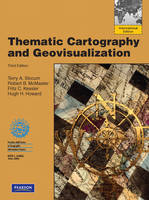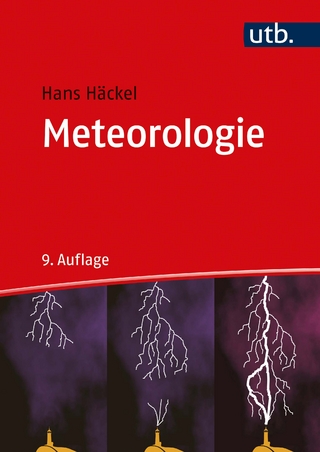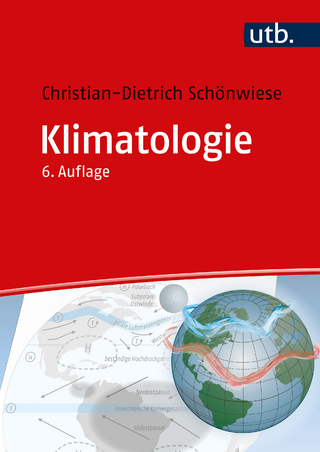
Thematic Cartography and Geovisualization
Pearson (Verlag)
978-0-13-801006-5 (ISBN)
- Titel erscheint in neuer Auflage
- Artikel merken
This comprehensive text blends broad coverage of basic methods for symbolizing spatial data with an introduction to cutting-edge data visualization techniques. The authors’ balanced presentation clearly contrasts different approaches for symbolizing spatial data, in addition to individual mapping techniques.
Terry A. Slocum currently is an Associate Professor in the Department of Geography at the University of Kansas. He received his B.A. and M.A. from SUNY at Albany, and his Ph.D. from the University of Kansas. Professor Slocum has published extensively in numerous refereed outlets, including Cartography and Geographic Information Science, Cartographica, Journal of Geography, Annals of the Association of American Geographers, The Professional Geographer, and The British Cartographic Journal. He has authored the books Thematic Cartography and Visualization (Prentice-Hall, 1999) and Thematic Cartography and Geographic Visualization (Pearson Education, Inc., 2005) . From 1999 to 2002 , he served as editor of Cartography and Geographic Information Science. He has been involved in numerous grants, including two from the National Science Foundation, and has received two Teacher Appreciation awards from the Center for Teaching Excellence (CTE) at the University of Kansas. From 2003 to the present, he has served as Chair of the Department of Geography at the University of Kansas. Fritz Kessler is currently an Associate Professor at Frostburg State University (FSU) located in Frostburg, MD and has been teaching a variety of geography courses since the fall of 1999. Professor Kessler’s cartographic background has evolved through a variety of cartographic related positions. He began his career in cartography while working in Ohio University’s Cartographic Center as an undergraduate student. After graduating from Ohio University in 1988 with a B.S. in Geography, he worked for the USGS Water Resource Division in Towson, MD as a Cartographic Technician. After receiving his M.S. from Penn State in 1991, he joined Intergraph as a Systems Analyst in Huntsville, AL. Desirous to return to production cartography, he took a position with R. R. Donnelley and Sons as a Cartographer. Although a fascinating experience, he chose to return to pursue his Ph.D. at the University of Kansas, during which time he worked for the Kansas State Geological Survey as a GIS Technician and as a Map Librarian at the T. R. Smith Map Library. In his ninth year of teaching at FSU, Fritz also holds a joint appointment through Penn State where he teaches and online course on map projections, datums, and coordinate systems in the Master of Geographic Information Systems degree program. Fritz has published in Cartographica, Cartography and Geographic Information Science, and American Congress on Surveying and Mapping’s Bulletin. Fritz is currently the Editor of Cartographic Perspectives, a peer-reviewed journal focusing on a broad array of cartographic topics, has served on the North American Cartographic and Information Society’s Board of Directors, and was the Secretary in the International Cartographic Association’s Working Group on Map Projections.
PART I
Introduction
1. Thematic Cartography and Geovisualization
1.1 What is a Thematic Map?
1.2 How are Thematic Maps Used?
1.3 Basic Steps for Communicating Map Information
1.4 Consequences of Technological Change in Cartography
1.5 Geovisualization
1.6 Related Techniques
1.7 Cognitive Issues in Cartography
1.8 Social and Ethical Issues in Cartography
2. A Historical Perspective on Thematic Cartography
2.1 A Brief History of Cartography
2.2 History of Thematic Cartography
2.3 History of U.S. Academic Cartography
2.4 The Paradigms of American Cartography
3. Statistical and Graphical Foundation
3.1 Population and Sample
3.2 Descriptive Versus Inferential Statistics
3.3 Methods for Analyzing Spatial Data, Ignoring Location
3.4 Numerical Summaries in Which Location Is an Integral Component
PART II
Principles of Cartography
4. Data Classification
4.1 Common Methods of Data Classification
4.2 Using Spatial Context to Simplify Choropleth Maps
4.3 Using Multiple Criteria to Determine Class Intervals
5. Principles of Symbolization
5.1 Nature of Geographic Phenomena
5.2 Levels of Measurement
5.3 Visual Variables
5.4 Comparison of Choropleth, Proportional Symbol, Isopleth, and Dot Mapping
5.5 Selecting Visual Variables for Choropleth Maps
6. Scale and Generalization
6.1 Geographic and Cartographic Scale
6.2 Definitions of Generalization
6.3 Models of Generalization
6.4 The Fundamental Operations of Generalization
6.5 An Example of Generalization
6.6 MapShaper: A Free Web-Based Generalization Service
7. The Earth and Its Coordinate System
7.1 Basic Characteristics of the Earth’s Graticule
7.2 A Brief History of Latitude and Longitude
7.3 Determining the Earth’s Size and Shape
8. Elements of Map Projections
8.1 The Map Projection Concept
8.2 The Reference Globe and Developable Surfaces
8.3 The Mathematics of Map Projections
8.4 Map Projection Characteristics
8.5 Distortion on Map Projections
8.6 Projection Properties
9. Selecting an Appropriate Map Projection
9.1 Potential Selection Guidelines
9.2 Examples of Selecting Projections
10. Principles of Color
10.1 How Color Is Processed by the Human Visual System
10.2 Hardware Considerations in Producing Color Maps for Graphics Displays
10.3 Models for Specifying Color
11. Map Elements and Typography
11.1 Alignment and Centering
11.2 Map Elements
11.3 Typography
12. Cartographic Design
12.1 Cartographic Design
12.2 Case Study: Real Estate Site Suitability Map
13. Map Reproduction
13.1 Reproduction Versus Dissemination
13.2 Planning Ahead
13.3 Map Editing
13.4 Raster Image Processing for Print Reproduction
13.5 Screening for Print Reproduction
13.6 Aspects of Color Printing
13.7 High-Volume Print Reproduction
13.8 Nonprint Reproduction and Dissemination
PART III
Mapping Techniques
14. Choropleth Mapping
14.1 Selecting Appropriate Data
14.2 Data Classification
14.3 Factors for Selecting a Color Scheme
14.4 Details of Color Specification
14.5 Legend Design
14.6 Classed Versus Unclassed Mapping
15. Dasymetric Mapping
15.1 Selecting Appropriate Data and Ancillary Information
15.2 Eicher and Brewer’s Work
15.3 Mennis and Hultgren’s Intelligent Dasymetric Mapping (IDM)
15.4 LandScan
15.5 Langford and Unwin’s Generalized Dasymetric Approach
16. Isarithmic Mapping
16.1 Selecting Appropriate Data
16.2 Manual Interpolation
16.3 Automated Interpolation for True Point Data
16.4 Criteria for Selecting an Interpolation Method for True Point Data
16.5 Limitations of Automated Interpolation Approaches
16.6 Tobler’s Pycnophylactic Approach: An Interpolation Method for Conceptual Point Data
16.7 Symbolization
17. Proportional Symbol and Dot Mapping
17.1 Selecting Appropriate Data For Proportional Symbol Maps
17.2 Kinds of Proportional Symbols
17.3 Scaling Proportional Symbols
17.4 Legend Design for Proportional Symbol Maps
17.5 Handling Overlap on Proportional Symbol Maps
17.6 Redundant Symbols
17.7 Selecting Appropriate Data for Dot Maps
17.8 Creating a Dot Map
18. Multivariate Mapping
18.1 Bivariate Mapping
18.2 Multivariate Mapping Involving Three or More Attributes
18.3 Cluster Analysis
19. Cartograms and Flow Maps
19.1 Cartograms
19.2 Flow Mapping
Part IV
Geovisualization
20. Visualizing Terrain
20.1 Nature of the Data
20.2 Vertical Views
20.3 Oblique Views
20.4 Physical Models
21. Map Animation
21.1 Early Developments
21.2 Visual Variables and Categories of Animation
21.3 Examples of Animations
21.4 Using 3-D Space to Display Temporal Data
21.5 Does Animation Work?
22. Data Exploration
22.1 Goals of Data Exploration
22.2 Methods of Data Exploration
22.3 Examples of Data Exploration Software
23. Visualizing Uncertainty
23.1 Basic Elements of Uncertainty
23.2 General Methods for Depicting Uncertainty
23.3 Visual Variables for Depicting Uncertainty
23.4 Applications of Visualizing Uncertainty
23.5 Studies of the Effectiveness of Methods for Visualizing Uncertainty
24. Web Mapping
24.1 A Brief History of Web Mapping
24.2 Cartographic Web Sites: A Classification
24.3 Tying Together the Five Continua
25. Virtual Environments
25.1 Defining Virtual and Mixed Environments
25.2 Technologies for Creating Virtual Environments
25.3 The Four “I” Factors of Virtual Environments
25.4 Applications of Geospatial Virtual Environments
25.5 Research Issues in Geospatial Virtual Environments
25.6 Developments in Mixed Environments
25.7 Health, Safety, and Social Issues
26. Trends in Research and Development
26.1 Linked Micromap Plots and Conditioned Choropleth Maps
26.2 Using Senses Other Than Vision to Interpret Spatial Patterns
26.3 Collaborative Geovisualization
26.4 Multimodal Interfaces
26.5 Information Visualization and Spatialization
26.6 Spatial Data Mining
26.7 Visual Analytics
26.8 Mobile Mapping and Location-Based Services
26.9 Keeping Pace with Recent Developments
Appendix: Lengths of One Degree Latitude and Longitude
Glossary
References
Index
| Erscheint lt. Verlag | 25.6.2009 |
|---|---|
| Sprache | englisch |
| Maße | 209 x 276 mm |
| Gewicht | 1252 g |
| Themenwelt | Naturwissenschaften ► Geowissenschaften ► Allgemeines / Lexika |
| Naturwissenschaften ► Geowissenschaften ► Geografie / Kartografie | |
| ISBN-10 | 0-13-801006-4 / 0138010064 |
| ISBN-13 | 978-0-13-801006-5 / 9780138010065 |
| Zustand | Neuware |
| Informationen gemäß Produktsicherheitsverordnung (GPSR) | |
| Haben Sie eine Frage zum Produkt? |
aus dem Bereich



